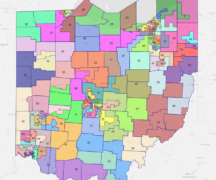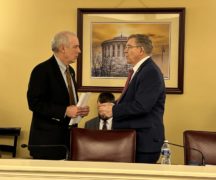By DAVID DUPONT
BG Independent News
The Ohio Redistricting Commission wrapped up its public hearings Friday (Aug.27). That included a session held Thursday in Toledo. Now the commission has until Sept. 1 to Wednesday to issue a report.
The Toledo hearing unfolded as many of the preceding seven had – nary a good word was spoken about gerrymandering.
The overall complaint among those who spoke was that the way the state’s legislative and congressional maps are draw overstates the impact of the Ohio’s Republican majority.
While Republicans do have a majority, it is not as great as its supermajority in the state legislature would indicate. Witness after witness said that is a result of the way district are drawn
As State Sen. Vernon Sykes pointed out – these hearing were focused on the state’s district, not congressional districts, but the bleed over was inevitable.
And some speakers, including Michael Galbraith, of Maumee, who waged an unsuccessful bid unseat U.S. Rep. Bob Latta, R-Bowling Green, in 2018. As a Democrat, noted that when Democrats had the upper hand they engaged in similar map-drawing shenanigans. His father, who served in the state legislature from 1967-1986, as a Republican, fell victim.
These districts often include voters with divergent interests – rural voters more invested in farming while suburban voters are more interested in water quality.
“The state is overwhelmingly ruled by rural and suburban interests,” said Larry Clark from Toledo. The districts have been drawn in such a way to minimize the voices of city residents.
And this affects the legislation that’s considered and is passed.
When districts are drawn to make them safe for incumbents, Kay Chapman, of Bowling Green said, problems such as the water quality in Lake Erie and the Maumee River, and “shameful” animal cruelty laws are neglected. “These problems get kicked down the road.”
Debbie Dalke of Bowling Green noted that based on the population standards, Wood County will be too big to be a single Ohio House seat. After the 2020 census, the county’s population is 132,248.
Sykes said at the beginning that the ideal size of a house district would be 119,281, and should not vary from that by more than 5 percent in either direction. Senate district should be 357,559 give or take 5 percent.
Dalke said that Bowling Green relies on Toledo. When her mother-in-law needed critical care. She was transferred to a Toledo Hospital. “This dramatically illustrates how important Toledo is to my life.”
Yet none of Bowling Green’s legislative – U.S. House, Ohio House and Senate – include any part of Toledo. The state senate district extends from Wood County to just beyond Archbold in the west to the Cleveland suburbs to the east, and includes Ottawa and Erie counties, which are connected only by a bridge of Sandusky Bay.
The commission needs to hold further hearings once preliminary maps are drawn up to get feedback on the actual boundaries, Dalke said.
Trevor Martin, an activist with Fair Districts Ohio, criticized the commission for not having map drawing software that’s accessible to the public. Fair Districts Ohio is even hosting a competition to encourage people to draw their own maps.
As districts are now drawn many voters feel their voices go unheard. Anesa Miller, of Bowling Green, said she and her late husband moved to Bowling Green because of its support for green energy.
Yet, both the city’s representatives, State Sen. Theresa Gavarone and State Rep. Haraz Ghanbari, voted for the controversial House Bill 6 that provided subsidies for nuclear and coal power and gutted many of the state’s alternative energy mandates. They also supported Senate Bill 52, which adds additional hurdles to solar projects in rural areas.
As it stands, Miller said, “legislators are insulated from wishes of their own constituents who may be outside the base of their primary supporters.”
For Marissa Bramble, a BGSU student from Defiance, the proposed legislation aimed at banning schools from teaching “divisive topics” reflects the imbalance brought about by gerrymandering.
This concern, she said, grew out of the protest for racial justices in 2020. She said she was active in organizing the protests in Defiance.
Now politicians in Columbus want to stop teaching what they frame as Critical Race Theory.
This would only divide the country more, Bramble said.
“Our current curriculum is whitewashed to paint America as this perfect place, and that simply is not the case,” she said. The country was founded by “wiping out” indigenous people and taking their land, and the economy was built on the labor of enslaved people.
Students need to learn of these and other faults, and how the country worked to address them. However, “unethical” districting only promulgates these injustices.
The process itself came under fire. The commission is made up of five Republicans and two Democrats. That included Gov. Mike DeWine who did not attend any of the hearings, and instead sent a designee.
Meetings were all held in urban centers, on weekdays, during the middle of the day, making it hard for a lot of people to participate, Chapman said. “Let’s do the right thing now instead of doing one more bad thing to be ashamed of.”
The new plan must be approved by a majority of the commission including two members from each party. Those districts would then be good for 10 years. If not it can be passed by a simple majority. Such a plan would only be in place for four years.





